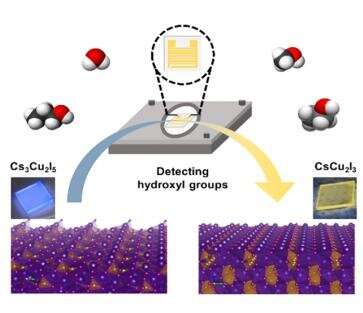The crystal structure can be changed by water molecules. Credit: Korea Institute of Materials Science (KIMS)
A joint research team in Korea succeeded in identifying the reaction principle of the high-selectivity gas sensing material and developing the world's first multi-response high-selectivity gas sensor that can simultaneously take optical and electrical measure measurements. The teams are led by Dr. Jin Woo Choi of the Department of Energy and Electronic Materials at the Korea Institute of Materials Science (KIMS), Dr. Han Seul Kim of the Korea Institute of Science and Technology Information (KISTI), and Professor Hyung Woo Lee of Pusan National University.
Existing semiconductor gas sensing materials detect gas as molecules of gas are adsorbed on the surface of the sensing layer resulting in electrical resistance change. The existing materials are underutilized, since the gas selectivity is low as the resistance changes regardless of the type of gas, and in most cases, electrical property change is the only indicator. The research team developed a new material whose crystal structure changes when exposed to a specific gas and based on this, produced a high-selectivity gas sensor that changes color and resistance at the same time.
The research team synthesized non-toxic Cs3Cu2I5, a copper-based eco-friendly metal halide thin film material. They confirmed that the material can reversibly change through supercomputer-based simulations and proved that water molecules are effective stimulants for crystal change. The team manufactured a sensor device based on this theory and identified that the device can successfully detect water molecules. By simultaneously utilizing electrical properties and color changes, they succeeded in successfully distinguishing various alcohols of different polarities.
In 2021, the global gas sensor market value was $1 billion and is expected to grow by 7.5% annually. Semiconductor gas sensor technology is suitable for lightweight products as well as miniaturization and mass production, which can be used in various fields such as mobile phones, Internet of Things (IoT), agriculture, and livestock industry. This technology has important research value as it presented a new sensor concept and demonstration case using a material having a changeable crystalline structure for the first time in the world.
The principal investigators, Dr. Jin Woo Choi, a senior researcher at KIMS and Dr. Han Seul Kim, a senior researcher at KISTI says that "this research suggests a new direction for development of semiconductor sensor devices and new materials. Due to its response characteristics, the new sensing material is expected to be applied to various industries such as agriculture, livestock, medical, and mobile."
The research was published in Advanced Functional Materials.
Currently, the research team is working on maximizing selectivity by using photo-electrical responsiveness in combination and synthesizing new crystalline materials to respond to various gases.
More information: Daseul Lee et al, Multimodal Gas Sensor Detecting Hydroxyl Groups with Phase Transition Based on Eco‐Friendly Lead‐Free Metal Halides (Adv. Funct. Mater. 28/2022), Advanced Functional Materials (2022). DOI: 10.1002/adfm.202270160
Journal information: Advanced Functional Materials
Provided by National Research Council of Science & Technology
























